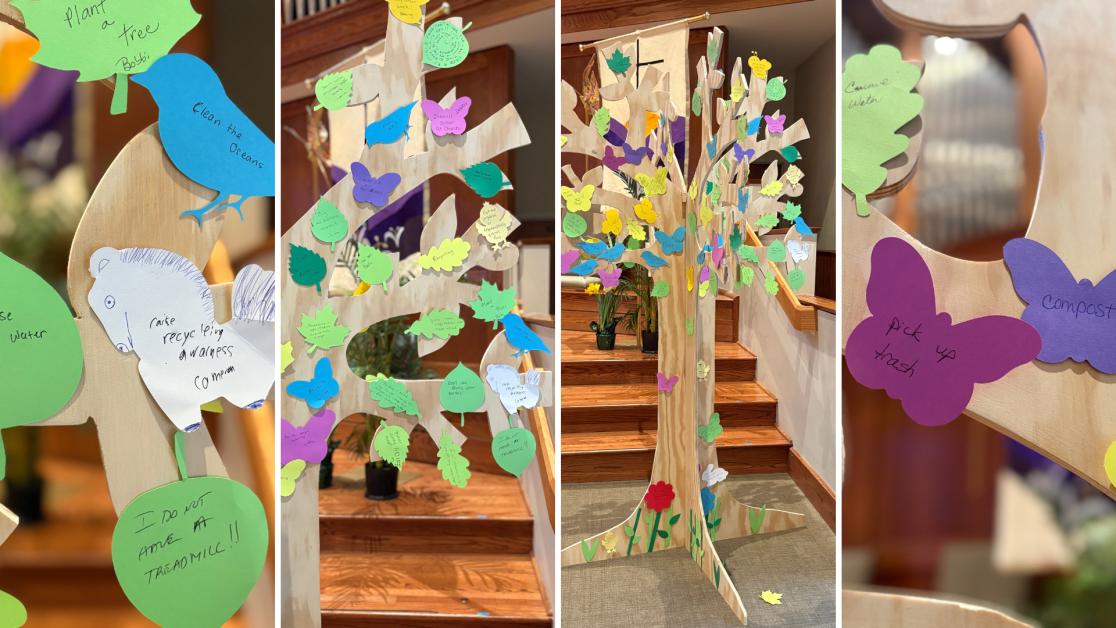
At the end of Earth Month, I’ve been reflecting on the growing tree in our Fellowship Hall—not a real one, but one just as alive. As you can see in the photo, you can see what I mean: colorful leaves, blossoms, birds and pollinators sprouting across the branches, each one representing an action someone in our church has taken—or hopes to take—to care for God’s creation.
Some of the leaves are simple and sweet:
“Turn off lights when leaving a room.”
“Walk to school instead of drive.”
“Grow my own vegetables.”
Others are bolder:
“Stop using plastic water bottles.”
“Plant a tree.”
“Install solar panels at church.”
“Switch to cloth napkins at home.”
Together, they form a living testimony—not just to environmental awareness, but to faith in action. It’s beautiful. And it’s holy.
Throughout April, we invited our congregation to reflect on three questions:
- What can I do to care for creation?
- What can we do together as a church?
- What can the world do to better care for this planet and one another?
From small children to older adults, people responded—not just with ideas, but with intention. And we made those intentions visible by placing them on our Tree of Life.
Because caring for creation isn’t just about policy or science or even best practices, it’s about discipleship. It’s about the daily ways we respond to God’s gift of life—life that we’ve been entrusted with for this generation and the next.
Back on Easter Sunday, we proclaimed the good news: “Christ is risen!” But I also proclaimed something else—something just as vital: Easter shows us that this life matters. These bodies matter. This planet matters.
The resurrection isn’t an escape plan from the earth. It’s a declaration that God’s love is rooted in creation. That Jesus didn’t rise as a disembodied spirit floating above it all—Jesus rose in a body. He ate with friends. He walked along dusty roads. He appeared in a garden.
In Revelation, the final vision of redemption doesn’t take place off the planet, but right here—with a tree of life growing at the heart of the New Creation. The tree’s leaves, we’re told, are “for the healing of the nations” (Rev. 22:2).
That’s not just a poetic image. It’s a sacred reminder: what we do to care for the earth and one another is part of God’s vision for restoration. Each leaf on our tree in Fellowship Hall bears a name—sometimes visible, sometimes just implied. But more than anything, each one carries hope. And responsibility. Imagine what it means for your name to be recorded on the Tree of Life—not just in Revelation’s vision of the end, but right now, in how we live. In how we care. In how we steward the water, the soil, the air, and the lives of the creatures (and people!) around us. It’s not about perfection. It’s about participation.
Earth Month may be ending, but our calling to creation care doesn’t have an expiration date. Every day we are given breath, every day we are rooted on this good earth, we are stewards of what God has made.
Let’s keep growing the Tree of Life. Let’s keep making decisions—from the way we shop to the way we build—that honor the resurrection truth that this world matters. Let’s keep imagining what it would look like for our church’s name to be recorded as one that loved the planet, loved its people, and reflected the light of Christ.
Every reusable bag. Every new habit. Every changed light bulb. Every tree planted. Every commitment made… It all adds up to a forest of hope.
And by the grace of God, that forest will grow.

